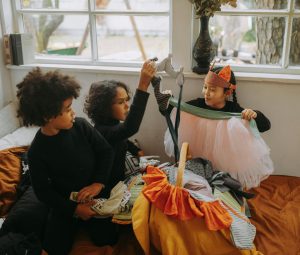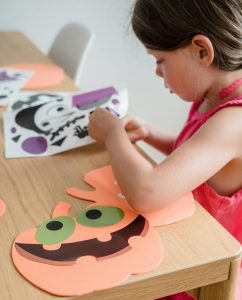 7 Therapist-Approved Tips to Help Anxious and Sensory-Sensitive Kids This Halloween
7 Therapist-Approved Tips to Help Anxious and Sensory-Sensitive Kids This Halloween
Takeaway: Halloween can be overwhelming for children who experience anxiety or sensory sensitivities, making loud noises, costumes, and crowds feel more stressful than fun. At Milika Center for Therapy and Resilience, we support families with tools that reduce stress and build resilience, so kids can enjoy meaningful moments with more confidence. In this article, we’ll share seven therapist-approved tips to help anxious and sensory-sensitive kids have a calmer, happier Halloween.
Halloween is meant to be fun, but for many kids, it brings more stress than joy. Costumes, crowds, and loud decorations can create Halloween anxiety in children, especially those who are sensitive to sensory overload. For parents, it can feel discouraging to watch an exciting tradition become overwhelming.
At Milika Center for Therapy and Resilience, we help families navigate moments like these with practical tools and coping strategies that reduce stress and build resilience. In this article, we’ll share seven therapist-approved tips to help anxious and sensory-sensitive kids this Halloween, so your family can focus on fun and connection.
Why Halloween Can Be Overwhelming for Kids
Halloween sensory overload happens when the combination of flashing lights, spooky decorations, and noisy crowds becomes too much for a child’s nervous system to process. Scratchy costumes or masks that don’t feel right can also heighten discomfort, making it harder for kids to feel at ease.
We often see how these sensory challenges overlap with emotional ones. Beyond the physical discomfort, Halloween fears in children, such as being surrounded by strangers, scary masks, or navigating new social expectations, can trigger anxiety. Even simple changes to routines, like being out late or eating more sugar than usual, can make kids feel unsettled.
Recognizing these challenges is the first step. When parents understand why Halloween feels overwhelming, they’re better equipped to create a calmer, more enjoyable experience for their children.
Therapist-Approved Tips for a Calmer, Happier Halloween
Halloween should be a time of costumes, candy, and fun. But for children with anxiety or sensory sensitivities, the noise, crowds, and unfamiliar routines can feel overwhelming instead of exciting. The good news is that with a bit of preparation and a few therapist-approved strategies, parents can make Halloween calmer, more comfortable, and still full of joy.
1. Start Preparing Early
One of the best ways of preparing anxious children for Halloween is to start talking about it well before the big night. Walk your child through what to expect: when you’ll go out, who you’ll be with, and how the evening might unfold.
Role-play trick-or-treating at home, practice saying “thank you,” and let them try on costumes in advance. These small steps reduce uncertainty and boost confidence. This preparation is key for parents wondering how to help anxious kids enjoy Halloween—because predictability helps kids feel safe.
2. Choose Sensory-Friendly Costumes
Uncomfortable outfits can turn a fun night into a stressful one. When possible, choose costumes for sensory-sensitive kids made of soft, tag-free fabrics or consider alternatives like Halloween-themed pajamas, T-shirts, or leggings. If masks or face paint feel overwhelming, skip them entirely. For children with sensory sensitivities, even small details can trigger irritation and escalate into sensory overload.
The goal isn’t to have the flashiest costume—it’s to make sure your child feels good in what they’re wearing. When kids are comfortable, they’re more likely to enjoy the night. These small, thoughtful adjustments are some of the most effective Halloween tips for kids with sensory issues, helping prevent stress and meltdowns before they even begin.
3. Create a Calm Plan for the Evening
Structure is a powerful tool in easing Halloween anxiety in children. Before heading out, plan your route, decide how long you’ll be out, and build in breaks along the way. Share this plan, or better yet, create this plan with your child so they know what to expect.
For families staying home, create a schedule for activities like handing out candy or watching a festive movie. Having a clear plan turns uncertainty into predictability, offering kids natural coping strategies on Halloween to feel secure.
4. Introduce Calming Tools
When overstimulation hits, grounding strategies can make all the difference. Pack a small fidget toy, a weighted lap pad, or noise-reducing headphones to help reduce Halloween anxiety. A favorite blanket or stuffed animal can also provide comfort. These items act as anchors, giving children quick access to familiar calming strategies during Halloween so they can reset and keep enjoying the night.
5. Take Breaks in a Safe Space
Even with preparation, kids may need a chance to regroup. Identify a “quiet zone” at home or even in the car where your child can take a break if things feel overwhelming. At community events, ask about designated sensory-friendly Halloween activities or calm-down spaces (or find your own if necessary). Stepping away for just a few minutes can ease stress and is one of the most effective Halloween anxiety coping strategies parents can use.
6. Offer Alternatives to Trick-or-Treating
Traditional trick-or-treating isn’t the only way to celebrate. If your child finds crowds too stressful, create a candy scavenger hunt at home, host a family pumpkin-decorating night, or look for low-key Halloween events in your community, like pumpkin decorating at a local library. These trick-or-treat alternatives for anxious kids allow them to enjoy the holiday without feeling pressured, while still creating fun, festive memories.
7. Validate and Normalize Feelings
Perhaps the most powerful gift you can give your child is empathy. Let them know it’s okay to feel nervous, scared, or overwhelmed. When parents are calm and validating, kids feel safe opening up. This practice not only eases Halloween worries but also teaches resilience for the future.
By supporting anxious children in this way, you show them that feelings are normal and manageable—and that you’re with them every step of the way. These moments of reassurance go a long way in helping kids with Halloween anxiety feel understood.
Building Resilient Halloween Memories with MILIKA
As a parent, it can feel discouraging when your child struggles with a holiday that’s supposed to be fun. But adapting traditions is not “less than”—it’s a powerful way of honoring your child’s unique needs. Choosing comfort over convention doesn’t take away from the joy of Halloween; it creates memories that are calmer, safer, and more meaningful.
At the Milika Center for Therapy and Resilience, we partner with families every day to help children develop coping skills, reduce anxiety, and build confidence in moments that feel overwhelming. Our therapists understand how sensory sensitivities and emotional challenges often intersect, and we provide practical, evidence-based support to help families feel prepared and resilient—not just during Halloween, but year-round.
If your child is struggling with anxiety or sensory sensitivities, know that you don’t have to navigate it alone. We invite you to reach out to our team to learn how therapy can support your family’s growth and connection.
FAQs: Helping Anxious and Sensory-Sensitive Kids During Halloween
1. How can I help my anxious child enjoy Halloween?
The best way to support an anxious child is by preparing them ahead of time for Halloween. Talk through what to expect, practice with costumes, and create a flexible plan that allows for breaks.
We also recommend validating your child’s feelings and focusing on what brings them joy—whether that means trick-or-treating for just a few houses or celebrating at home. These small steps are some of the most effective ways of learning how to help anxious kids enjoy Halloween.
2. What are sensory-friendly Halloween tips for kids?
Sensory-friendly Halloween tips include choosing soft, tag-free costumes, avoiding restrictive masks, and planning quieter activities, such as pumpkin decorating or themed crafts. Many families also benefit from creating a designated sensory break space where children can retreat if the Halloween sensory overload becomes too much.
3. How do I know if my child’s Halloween anxiety is normal or if they need more support?
It’s common for Halloween fears in children to include costumes, strangers, or loud noises. However, if anxiety is so intense that it prevents your child from enjoying not just Halloween but also everyday activities, it may be time to seek support. A therapist can help children build coping tools, practice calming strategies, and grow resilience.
4. What calming strategies can help kids during Halloween?
Calming strategies for kids during Halloween might include deep breathing, carrying a comfort item, using noise-reducing headphones, or taking breaks between houses. Even simple grounding exercises can ease stress in the moment.
5. How can parents make Halloween less stressful for kids with autism or sensory processing challenges?
Parents can reduce stress by tailoring the holiday to their child’s unique needs and interests. This could mean shorter outings, selecting costumes that are sensory-friendly for kids, or celebrating with alternative activities at home. Previewing events with pictures or stories can also help kids feel more prepared. Above all, the focus should be on comfort, safety, and fun—because that’s what creates lasting, positive Halloween memories.

 7 Therapist-Approved Tips to Help Anxious and Sensory-Sensitive Kids This Halloween
7 Therapist-Approved Tips to Help Anxious and Sensory-Sensitive Kids This Halloween


